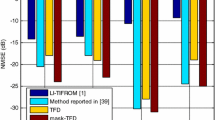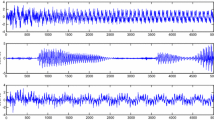Abstract
This paper presents a new time-frequency approach to the underdetermined blind source separation using the parallel factor decomposition of third-order tensors. Without any constraint on the number of active sources at an auto-term time-frequency point, this approach can directly separate the sources as long as the uniqueness condition of parallel factor decomposition is satisfied. Compared with the existing two-stage methods where the mixing matrix should be estimated at first and then used to recover the sources, our approach yields better source separation performance in the presence of noise. Moreover, the mixing matrix can be estimated at the same time of the source separation process. Numerical simulations are presented to show the superior performance of the proposed approach to some of the existing two-stage blind source separation methods that use the time-frequency representation as well.




Similar content being viewed by others
References
Comon P. Independent component analysis. A new concept? Signal Process. 1994;36:287–4.
He Z, Xie S, Ding S, Cichocki A. Convolutive blind source separation in the frequency domain based on sparse representation. IEEE Trans Audio Speech Lang Process. 2007;15:1551–63.
Levin DN. Performing nonlinear blind source separation with signal invariants. IEEE Trans Signal Process. 2010;58:2131–40.
Moussaoui S, Brie D, Mohammad-Djafari A, Carteret C. Separation of non-negative mixture of non-negative sources using a Bayesian approach and MCMC sampling. IEEE Trans Signal Process. 2006;54:4133–45.
Li Y, Amari S, Cichocki A, Ho DWC, Xie S. Underdetermined blind source separation based on sparse representation. IEEE Trans Signal Process. 2006;54:423–37.
Georgiev P, Theis F, Cichocki A. Sparse component analysis and blind source separation of underdetermined mixtures. IEEE Trans Neural Netw. 2005;16:992–6.
He Z, Cichocki A, Zdunek R, Xie S. Improved FOCUSS method with conjugate gradient iterations. IEEE Trans Signal Process. 2009;57:399–404.
De Lathauwer L, Castaing J, Cardoso J-F. Fourth-order cumulant-based blind identification of underdetermined mixtures. IEEE Trans Signal Process. 2007;55:2965–73.
De Lathauwer L, Castaing J. Blind identification of underdetermined mixtures by simultaneous matrix diagonalization. IEEE Trans Signal Process. 2008;56:1096–105.
Ferreol A, Albera L, Chevalier P. Fourth-order blind identification of underdetermined mixtures of sources (FOBIUM). IEEE Trans Signal Process. 2005;53:1640–53.
Aissa-El-Bey A, Linh-Trung N, Abed-Meraim K, Belouchrani A, Grenier Y. Underdetermined blind separation of nondisjoint sources in the time-frequency domain. IEEE Trans Signal Process. 2007;55:897–907.
Peng D, Xiang Y. Underdetermined blind source separation based on relaxed sparsity condition of sources. IEEE Trans Signal Process. 2009;57:809–14.
Linh-Trung N, Belouchrani A, Abed-Meraim K, Boashash B. Separating more sources than sensors using time-frequency distributions. EURASIP J Appl Signal Process. 2005.
Xie S, Yang L, Yang J-M, Zhou G, Xiang Y. Time-frequency approach to underdetermined blind source separation. IEEE Trans Neural Netw Learn Syst. 2012;23:306–16.
Gorodnitsky IF, Rao B. Sparse signal reconstruction from limited data using FOCUSS: a re-weighted minimum norm algorithm. IEEE Trans Signal Process. 1997;45:600–16.
Kiers HAL. Towards a standardized notation and terminology in multiway analysis. J Chemom. 2000;14:105–22.
De Lathauwer L, Castaing J. Blind identification of underdetermined mixtures by simultaneous matrix diagonalization. IEEE Trans Signal Process. 2008;56:1096–105.
Kruskal Joseph B. Three-way arrays: rank and uniqueness of trilinear decompositions, with application to arithmetic complexity and statistics. Linear Algebra Appl. 1977;18:95–138.
Kruskal JB. Rank, decomposition, and uniqueness for 3-way and n-way arrays, Multiway data analysis. Amsterdam: North-Holland; 1989. p. 7–18.
Jiang Tao, Sidiropoulos. Kruskal’s permutation lemma and the identification of CANDECOMP/PARAFAC and bilinear models with constant modulus constraints. N.D. IEEE Trans Signal Process 2004;52:2625–36.
Kolda TG, Bader BW. Tensor decompositions and applications. SIAM Rev. 2009;51:455–500.
De Lathauwer L. A link between the canonical decomposition in multilinear algebra and simultaneous matrix diagonalization. SIAM J Matrix Anal Appl 2006;28:642–66.
Allen Ronald L, Mills Duncan W. Signal analysis: time, frequency, scale, and structure. New York: IEEE press, Wiley; 2004.
He Z, Cichocki A, Xie S, Choi K. Detecting the number of clusters in n-way probabilistic clustering. IEEE Trans Pattern Anal Machine Intell. 2010;32:2006–21.
Boudreaux-Bartels G, Parks T. Time-varying filtering and signal estimation using Wigner distribution synthesis techniques. IEEE Trans Acoust Speech Signal Process. 1986;34:442–51.
Cichocki A, Amari S, Siwek K, Tanaka T, Phan AH. ICALAB toolboxes [Online]. Available: http://www.bsp.brain.riken.jp/ICALAB.
Acknowledgments
The work in this paper is partly supported by the National Natural Science Foundation of China under grants 61004054, 61103122, 61104053, and U1035001 and the Guangdong Natural Science Foundation (team project) under grant S2011030002886.
Author information
Authors and Affiliations
Corresponding author
Rights and permissions
About this article
Cite this article
Yang, L., Lv, J. & Xiang, Y. Underdetermined Blind Source Separation by Parallel Factor Analysis in Time-Frequency Domain. Cogn Comput 5, 207–214 (2013). https://doi.org/10.1007/s12559-012-9177-9
Received:
Accepted:
Published:
Issue Date:
DOI: https://doi.org/10.1007/s12559-012-9177-9




